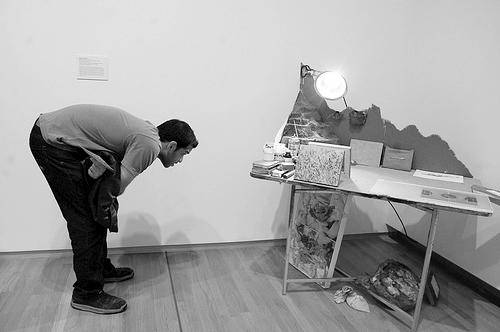Art is intimidating for most people. It’s difficult for someone to discern exactly what they like in a piece of artwork. Nasher Museum of Art in Durham helps solve that problem by offering disparate exhibitions that appeal to a broad audience.
The Nasher Museum of Art is well known for its affiliation with Duke University, which helps it attract well-known artists and extensive collections. The Museum features three exhibitions, “A Room of Their Own: The Bloomsbury Artists in American Collections,” “Sacred Beauty: Medieval and Renaissance Illuminated Manuscripts,” and “Escultura Social: A New Generation of Art from Mexico City.”
Wendy Hower Livingston, manager of marketing and communications for Nasher Museum, said, “These three exhibitions offer something for everyone. There’s contemporary art in ‘Escultura,’ works from a group of intellectuals responding to Victorian England in ‘Bloomsbury,’ and showcasing works from the permanent collection in ‘Sacred Beauty.'”
The Bloomsbury collection featured many artists who were influenced by European Post-Impressionism. Many had also dabbled in textiles, so the collection features embroidery and sketches for textile patterns along with sketches and painting. The decorative arts featured mainly pastel colors suitable for home furnishings, and the portraits and landscapes were painted in darker tones to convey realism. Literature shares common ground with art, since it features some book designs for certain works of Virginia Woolf, one of which being Mrs. Dalloway. The designs for stationary and matchbook labels indicate the beginnings of modern graphic design.
Sarah Schroth, Nancy Hanks Senior Curator at Nasher Museum, oversees all curatorial activities of the museum. Schroth’s most recent exhibition was 2008’s “El Greco to Velasquez: Art During the Reign of Philip III.” Although she did not personally curate the Bloomsbury collection, she was still involved.
“For the Bloomsbury collection, I was not heavily involved, but I oversaw the meetings and coordinated with Nancy Green at Cornell University,” Schroth said.
The manuscripts in “Sacred Beauty‚” were complemented by gold frames and cobalt blue walls. Most of the manuscripts were not attributed to one artist, but were instead credited to one or two countries in an estimate of the time of its making. Three pieces had lightboxes situated behind the manuscripts to show the effect of illumination, and some had snippets of music or writing to show how the artwork would fit within the written word.
“Escultura Social” featured the widest range of artistic media, ranging from textiles to ink to video. The viewer was welcomed into the exhibition by a taped video recording in Spanish and English. Works were accompanied with placards stating the artist’s name and cultural heritage as well as the title of the piece, materials used, permanent collection and artist’s explanation.
Certain notable works stand out from each of the exhibitions. Bloomsbury featured Vanessa Bell’s oil painting “Portrait of Mary St. John Hutchinson.” The angularity of the facial features indicates an awareness of Modigliani’s style. Bell and Duncan Grant also have more abstract works featuring simple shapes divided by heavy lines. Since abstraction had not yet come to the forefront of the art world at the time, these two were ahead of the curve.
“Sacred Beauty” had a work entitled “Harrowing of Hell,” from circa 1600, thought to be from Germany or the Netherlands. At first glance, the work was primarily of a heart-shaped wreath of flowers that are painted so realistically that they seem to extend beyond the frame. On closer glance, the center of the painting reveals a darker patch which depicts a man’s violent beating at the hands of two other men. The interplay between the flowers and the center vignette provides a striking contrast in the midst of the other rich-hued works.
In “Escultura Social,” artist Pedro Reyes had a video played on a loop. This video was a five-minute trailer for a fictitious film, with characters portrayed by wooden marionettes. The trailer involved a librarian who encouraged precocious young readers to borrow Karl Marx’s opus Das Kapital. Absurdity ensues when a malfunctioning microwave brings Marx to life. Soon, other historical figures also appear, among them Joseph Stalin, Che Guevara, and Adam Smith, who eventually engages in fisticuffs with Marx. The trailer features the traditional heart-warming moment when the librarian passionately kisses Che framed in a large heart against a pink backdrop, the scene scored by beach music that would not be out of place in Gidget.
According to the Nasher Museum Web site, “Escultura Social: A New Generation of Art from Mexico City” runs until June 7, and “Sacred Beauty: Medieval and Renaissance Illuminated Manuscripts” runs until May 10. “A Room of Their Own: The Bloomsbury Artists in American Collections” finished its run on April 5. Tickets for non-Duke students are $3.
Livingston said that Nasher has organized a show in Santa Monica, California, entitled “Berkeley L. Hendricks: Birth of Cool,” which has made the cover of this month’s ArtForum magazine. The exhibition has also been reviewed by the New York Times and ARTnews.
Schroth said that she is organizing a show for the summer.
“It will be treasures of photography from the Duke library, from the 1870s until now. It’ll be sort of a selection of 100 greatest hits,” Schroth said.
Other exhibitions in the works include an August exhibit on Picasso, which the Nasher Museum helped organize and can be currently seen at Yale. There is also an exhibition scheduled for August 2010 entitled “The Record.”
Livingston said, “There’s always something new and something for everyone. We have a very ambitious schedule for a museum of this size.”
The Nasher Museum of Art is located at 2001 Campus Drive in Durham on Duke University’s campus.








